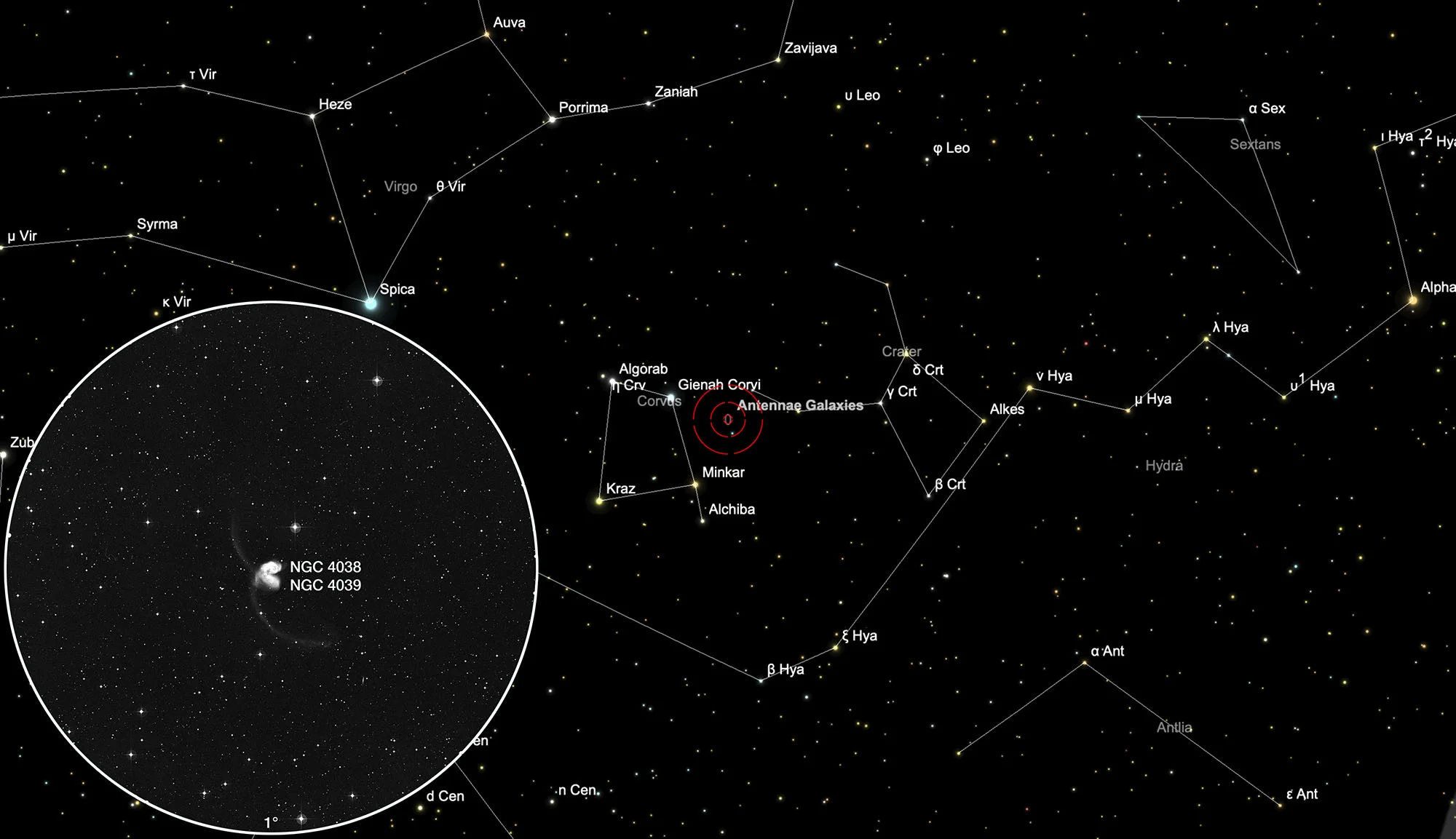Antennae Galaxies (NGC 4038/9)
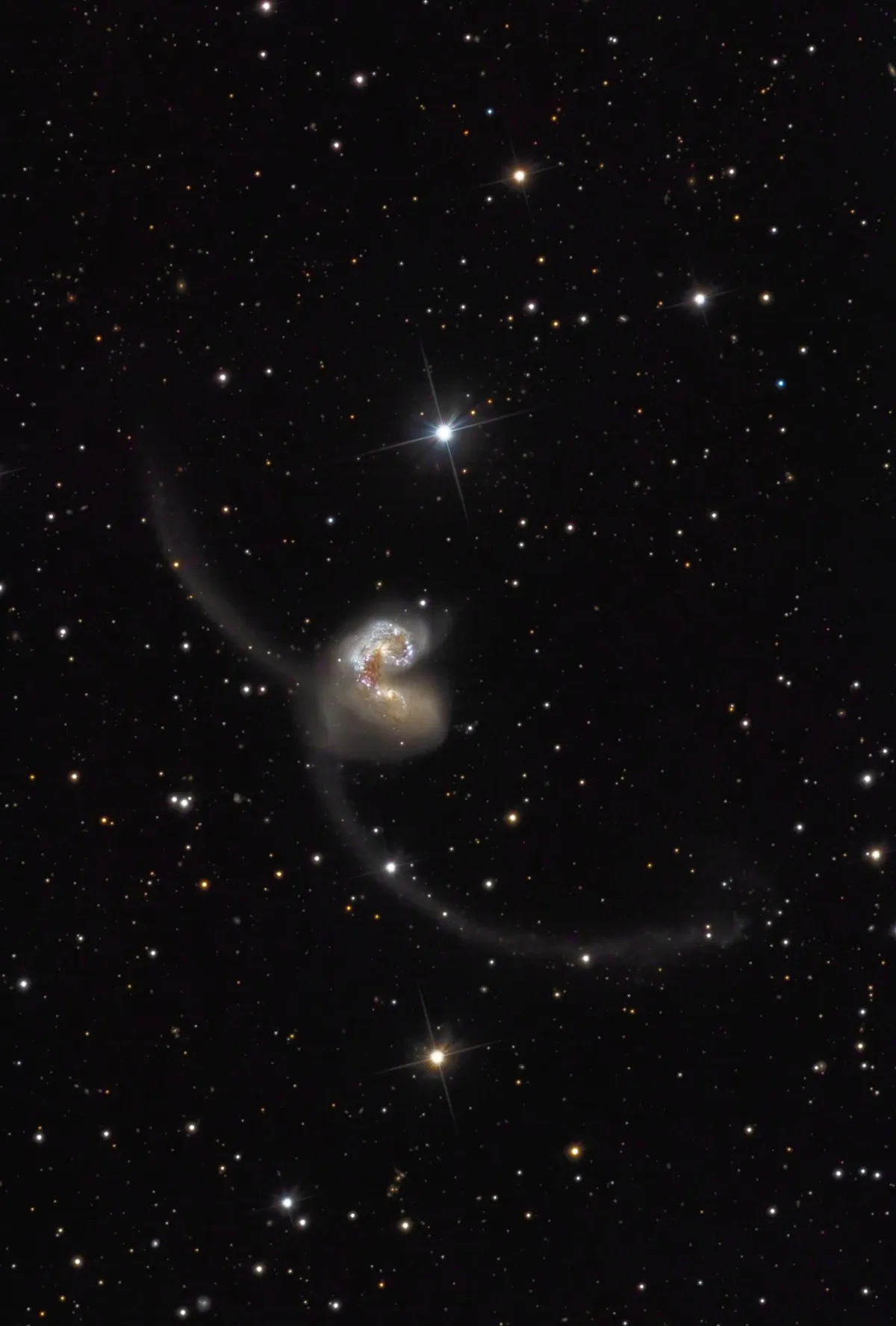
History
These two galaxies were discovered on 7 February 1785 by William Herschel using his 18.7 inch reflecting telescope. He listed them with single entry IV 28 and noted: «Pretty bright, large, opening with a branch, or two nebulae very faintly joined. The southern is smallest.» [463] John Herschel listed two entries. Notes for h 1052: «Very large, round, very gradually brighter in the middle; the chief nebula of a fine double nebula. The other is 2' south. They run together.» Notes for h 1053: «The northern of the double nebula. It is the smaller and fainter of the two.» [466] In 1888 Dreyer added the two nebulae as NGC 4038 and NGC 4039 in his «New General Catalogue». [313]
Physical Properties
The galaxy pair NGC 4038 and NGC 4039 are two colliding galaxies. The two bright central regions merge into two elliptical clumps that appear glued together on their eastern side. From there, two long, curved filaments extend, which reach far out into space. The more northerly can be traced for about five minutes of arc, the more southerly for more than ten. These two filaments resemble the long feelers of a beetle, hence the second nickname Antennae.
The two filaments emit strong radio radiation, which was discovered in 1957. The well-known astronomer Fritz Zwicky showed that the tidal forces of two colliding galaxies stimulate new star formation. Indeed, a nebulous region has been spotted at the end of NGC 4039's southern filament, which appears to be a young protogalaxy. Recently formed massive stars excite the surrounding gas from which they were formed to glow.
The remaining, relatively undisturbed regions of the two galaxies (Fig. 2 below) show only subtle colour differences, suggesting that the two were galaxies before their collision of the type S0 and not spiral galaxies. S0 galaxies are disc-shaped, relatively gas-poor galaxies whose colour is slightly yellower than that of the spiral galaxies. This could explain why star formation occurs mainly in one of the two galaxies - where the gas is.
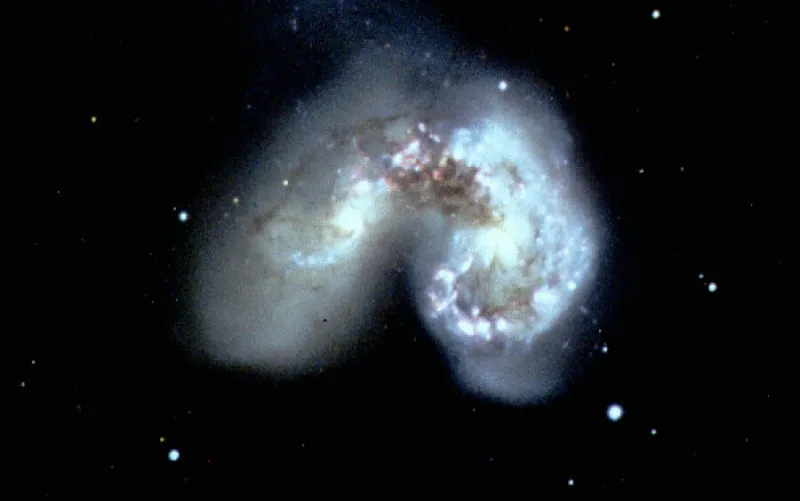
In the central regions of the two colliding galaxies, young star clusters were found with the help of the (then still uncorrected) Hubble Space Telescope, which should not be older than 10 million years. It is not yet clear whether they are open or globular clusters, but their mean radius of about 60 light-years is comparable to that of typical globular clusters in the Milky Way. Most form dense groups of about a dozen in the large H II region in which they were formed. [4, 112, 116]
According to LEDA [134], the two galaxies are moving away from the centre of the local group at a speed of about 1400 km/s, which at a Hubble constant of 75 km/s/Mpc is one distance of about 60 million light years. NGC 4038's spin axis is tilted at about 65° to our viewing direction, and NGC 4039's at about 71°.
| Name | RA | Dec | Type | bMag | vMag | B-V | SB | Dim | PA | z | D(z) | MD | Dreyer Description | Identification, Remarks |
|---|---|---|---|---|---|---|---|---|---|---|---|---|---|---|
| NGC 4038 | 12 01 52.8 | -18 51 52 | Gx (SBm) | 10.9 | 10.3 | 0.6 | 12.1 | 3.4 × 1.7 | 94 | 0.005477 | 23.13 | 20.880 | pB, cL, R, vgbM | WH IV 28.1; h 1052; GC 2670; ESO 572-47; MCG -3-31-14; UGCA 264; Arp 244; VV 245; Antennae |
| NGC 4039 | 12 01 53.8 | -18 53 08 | Gx (SBm) | 10.9 | 10.3 | 0.6 | 12.2 | 3.3 × 1.7 | 55 | 0.005474 | 23.12 | 20.880 | pF, pL | WH IV 28.2; h 1053; GC 2671; ESO 572-48; MCG -3-31-15; UGCA 265; Arp 244; VV 245; Antennae |
Finder Chart
West of the diamond-shaped asterism of the constellation Corvus, approximately one degree north of the 5.2-magnitude bright star 31 Crateries, lies the colliding galaxy pair NGC 4038/9. On 22 March, the galaxy pair is in opposition to the Sun and crosses the meridian at midnight local time. The best time to observe it is during the months of November to August. Since the two galaxies are relatively faint, it is best to use an eyepiece with medium magnification to locate them. Not far away lies the galaxy NGC 4027, which also belongs to the NGC 4038 group.
Visual Observation
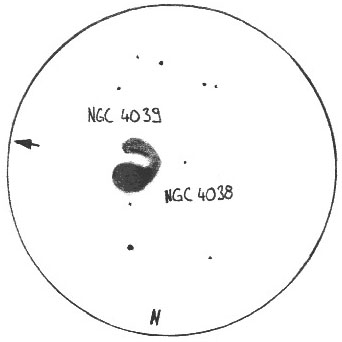
350 mm Aperture: Both cores appear very pronounced in the 14-incher. The northern galaxy NGC 4038 appears brighter and larger. The slightly fainter galactic core of NGC 4039 connects almost seamlessly to the south. In photos and with imagination on the sketch, the two galaxies are reminiscent of a fetus. The antennas on both galaxies are not visually accessible with amateur telescopes. — 14" PWO-Dobson, F:4.6 / TV-Radian 8mm, 200x, 0.3°, Eduard von Bergen[192]
400 mm Aperture: In the 21 mm Ethos eyepiece, the first thing you notice are two connected, misty ovals, which are reminiscent of a Prussian pastry. Even at higher magnification no more details were visible, let alone the antennas. The proximity of the horizon and the impending moonrise were not very helpful here. — 400 mm f/4.5 Taurus Dobsonian, Hasliberg, SQM 21.2, 3. 2. 2024, Bernd Nies
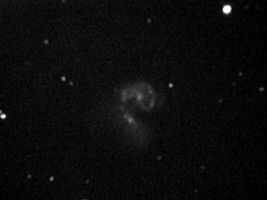
762 mm aperture: The visual impression can be roughly reproduced with a MallinCam video camera and an integration time of around three seconds. A tracking 30 inch f/3.3 SlipStream Dobsonian was used. The resulting image comes very close to visual vision with a 13 mm Tele Vue Ethos eyepiece. — 14. 3. 2012, Eduard von Bergen
